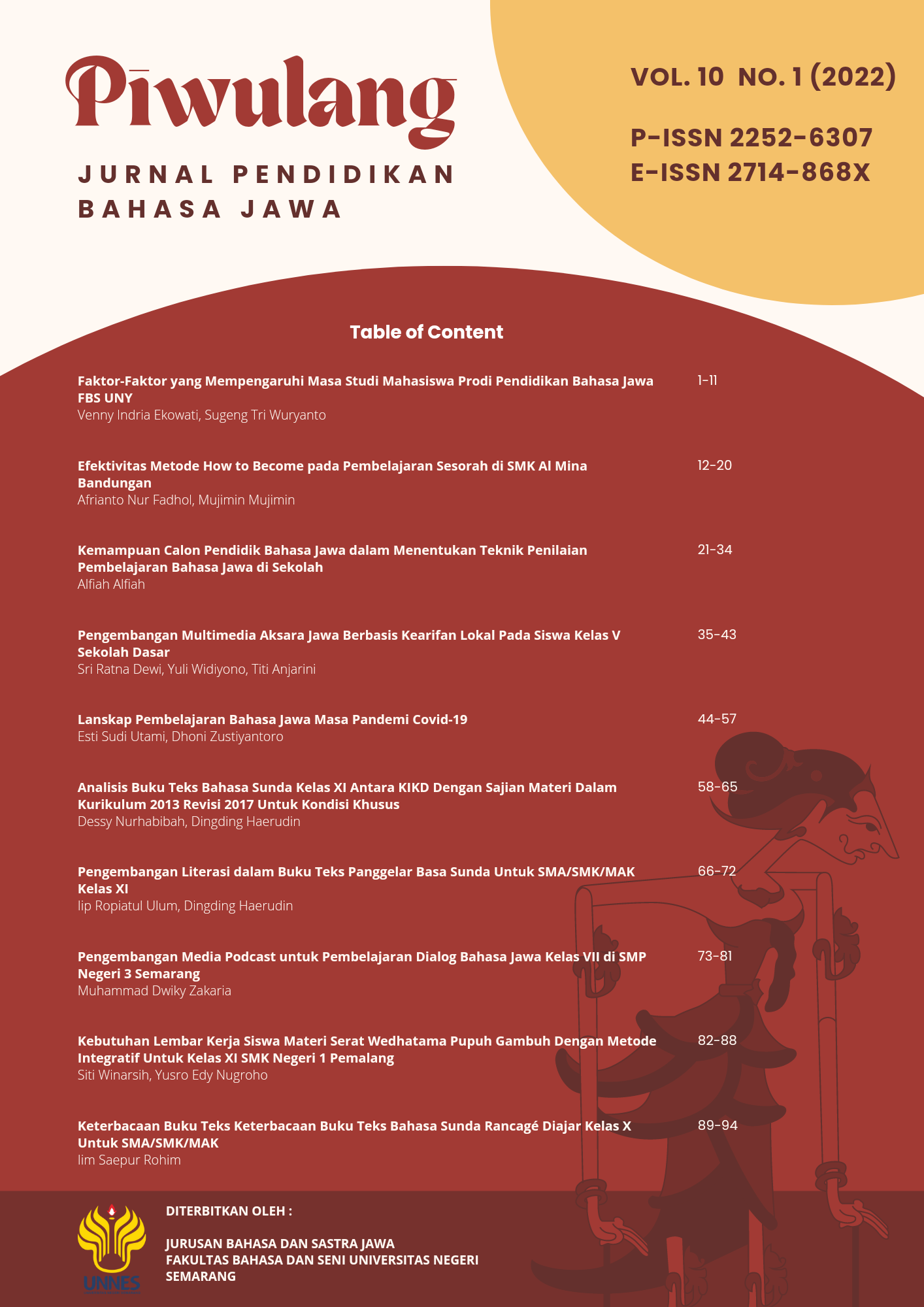Efektivitas Metode How to Become pada Pembelajaran Sesorah di SMK Al Mina Bandungan
##plugins.themes.academic_pro.article.main##
Abstract
School regulation at SMK Al Mina Bandungan regarding time management of the study and the students’ activities becomes a crucial thing for the teacher to determine effective learning methods. Based on the research background, this study aimed to assess the effectiveness of the “How to Become” method in sesorah learning at SMK Al Mina Bandungan. This study employed experimental research which used Quasi-Experimental Design as an approach to compare the two research groups which are not correlated. The data analysis used in this study were T-Test and N-Gain. The result of statistical analysis showed that the data from both the experimental group and control group were distributed normally and homogenous. After the study measurement, the T-Test result showed that there were no significant differences between those two groups. Whereas, the N-gain result showed that the pretest and post-test score improvements of the experimental group were higher than the control group with insignificant differences. According to the statistical report and some other factors, it can be concluded that the “How to Become” method is not effective for sesorah learning at SMK Al Mina Bandungan.
##plugins.themes.academic_pro.article.details##
References
Baroroh, Kiromim. (2011). Upaya Meningkatkan Nilai-Nilai Karakter Peserta Didik Melalui Penerapan Metode Role Playing. Jurnal Ekonomi & Pendidikan. 8(2), 149-163.
Djaelani, M. (2010). Metode Penelitian bagi Pendidik. Jakarta: PT Multi Kreasi Satudelapan.
Ismail, Fajri. (2018). Statistika untuk Penelitian Pendidikan dan Ilmu-Ilmu Sosial. Jakarta: Kencana.
Krisdiana, B. P., Irawati, E., & Kadarisman, A. E. (2018). The Effectiveness of Role-Play Integrated with Word Cards on Students ’ Speaking Skill for Communication. Jurnal Pendidikan Humaniora, 6(2), 78–84.
Lembang, Y. C. D., Ardiyani, D. L., & Muyassaroh, L. U. (2021) Efektivitas Model Pembelajaran Information Gap Activity Normalism (IG-AN) terhadap Keterampilan Berbicara Peserta Didik Kelas X SMA. Journal of Language, Literature, and Arts, 1(3), 356-368.
Lestari, K. E., & Yudhanegara. (2017). Penelitian Pendidikan Matematika. Bandung: PT Refika Aditama.
Margasari, A. S. (2013). Penggunaan Metode STAD (Student Teams-Achievement Divisions) untuk Meningkatkan Keterampilan Sesorah pada Siswa Kelas XI TKR-C SMK Nawa Bhakti Kebumen Tahun Ajaran 2012/2013. Jurnal Prodi Bahasa Dan Sastra Jawa UMP, 02(01), 14–30.
Munaffingah, U. (2012). Trampil Micara Basa Jawa. Yogyakarta: Javalitera.
Nurgiyantoro, B. (2018). Penilaian Otentik dalam Pembelajaran Bahasa. Yogyakarta: Gadjah Mada University Press.
Oradee, T. (2013). Developing Speaking Skills Using Three Communicative Activities (Discussion, Problem-Solving, and Role-Playing). Journal International Journal of Social Science and Humanity, 2(6), 533–535.
Prayitno, D. (2017). Panduan Praktis Olah Data Menggunakan SPSS. Yogyakarta: Andi.
Sari, I. P. M., Ermawati F. U. (2021). Instrumen Tes Diagnostik Konsepsi Lima Tingkat pada Materi Gerak Lurus: Pengambangan, Uji Validitas dan Rehabilitas serta Uji Coba Terbatas. PENDIPA Jounal of Science Education. 5(2), 152-162.
Sari, R. W., Syamsuddin, Bachtiar, & Dalle, Ambo. (2021). Efektivitas Metode Mimicry-Memorization (Mim-Mem) dalam Penguasaan Kosakata (Mufradat) Siswa Kelas X SMA Pesantren Tarbiyah Takalar. Jurnal Al-Fashahah, 1(1), 22-31.
Syafril. (2019). Statistik Pendidikan. Jakarta: Kencana.
Setyonegoro, A. (2013). Pembelajaran Berbicara Berbasis Masalah : Strategi dan Pendekatan Sebagai Implementasi Kurikulum 2013. Junal Pena, 3(2), 29–41.
Susanto, A. (2015). Ketuntasan Pendekatan Pembelajaran Konstektual dalam Mengembangkan Kemampuan Menulis Naskah Pidato. Jurnal Wahana Pedagogika, 2(1), 77–82.
Wahyuni, E. (2013). Peningkatan Kemampuan Sesorah Informatif dengan Metode Pemodelan pada Siswa Kelas VIII SMP N 1 Purwareja Klampok Kabupaten Banjarnegara Tahun Ajaran 2012/2013. Jurnal Pendidikan Bahasa dan Sastra Jawa UMP, 03(04), 1–6.
